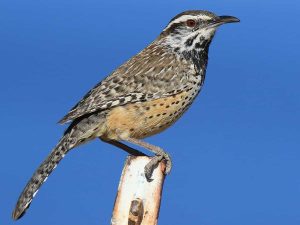When It comes to Cactus Wren, we are talking about one of the most famous birds in the world especially in the United States. this bird is considered also one of the largest desert birds as it’s similar in size to the Spotted Towhee.
There are a lot of things to explore about Cactus Wren, in addition, to answer for most questions that people ask about it, like what is the most unusual about the cactus wren? Why is it called Cactus Wren? Are cactus wrens carnivorous? and more questions.
What is The Cactus Wren?

The Cactus wren its Scientifique name is Campylorhynchus brunneicapillus, it’s a bird that lives in arid and semi-arid deserts in the southwestern and northern United States, southern California, Arizona, southern Nevada, southwest Utah, western Texas we can found it also in central Mexico, it’s a species of wren and considered from the largest wrens in United states.
What is the physical appearance of the cactus wren?
It has brown plumage with some white parts and black spots on its body, In terms of wingspan, it typically has a wingspan of around 30 to 40 centimeters (12 to 16 inches). This measurement refers to the distance between the tips of the extended wings when the bird is in flight and is a medium-sized bird native to the southwestern United States and northern Mexico. On average, an adult cactus wren measures about 18 to 23 centimeters (7 to 9 inches) in length from beak to tail.
Its sound is a loud raspy chirrup or chuh, chuh, chuh, There are people who describe it as the sound of a car engine before it takes off.
How does the Cactus Wren adapt to its arid habitat?
This bird adapts to its arid habitat by changing some behaviors and relying on different food and water sources.
the main source of food for this bird is seeds, aints, beetls, grasshoppers, and fruit pulp. and water sources can be lacking if it’s available these food sources that we mention also can be a source of water because they contain some water that they drink and save it on their bodies.
This bird in the summer season, doesn’t move a lot to keep some water on its body and doesn’t consume a lot of water. they save water and food on their nests when it’s available for these dry periods. and then they go back to their stocks and bring the water and food that they saved to consume.
Why is the cactus wren endangered?
Cactus wrens are endangered even though they are still abundant for many reasons like the dry areas where they live and the hard environment but this is not the main reason, the main reason for endangering Cactus Wren and most other species is human activities.
As we know humans are developing at a rapid pace and that’s a good sign but it’s not the same for birds and animals, because all this development reflects negatively on them, When humans start building houses, companies, factories, and everything, so they need space to do this, they are consuming the free and green spaces where these birds live, and that makes them migrate to other places to live even though it’s not suitable for them but there is no other solution.
In addition to cutting trees to get wood, when they are cutting trees my friend they are breaking home, food sources, and a place where their little ones gowing up.
The behavior of Cactus Wren:
These species are different from others in the side of behavior as they have no fear and the proof of this is that they don’t hide like other birds, they stay the whole day on aloe trees and other thorny trees to show themselves and their presence and they don’t raise their tails like others but they making it stay over their back.
Letting the tail stay over the back means showing aggression or dominance to make other species stay far away from their place and to assert their territory or intimidate other birds or animals that are encroaching on their territory.
Raising the tail, especially during the mating and breeding season, can be a sign of courtship and an attempt to excite females, in addition to performing many other expressive movements and dances to obtain happiness and mating.
Nesting Habits :
When the period of nest building came, both cactus wren male and female helped together to build it, as it is built from materials like dry grass, weeds, feathers, animal hair, twigs, and everything that they find in the space around them.
They collect all these materials and take them to a thorny tree, it may be (tree yucca), (cholla), acacia paloverde, or mesquite, this dress is the most suitable for their nests because it provides protection from animals and other species.
Egg Incubation:
Cactus Wrens have some pretty interesting ways when it comes to family planning. They usually gather up a clutch of around 3 to 5 eggs, which they tuck away carefully in cozy, cup-shaped nests they’ve woven into prickly shrubs or cacti. What’s really heartwarming is that both mom and dad take turns keeping those precious eggs warm for about 16 to 18 days. Once the little ones hatch, it’s all hands — or wings — on deck. Their doting parents serve up a hearty menu of insects and arthropods, making sure their youngsters get the best start in life.
